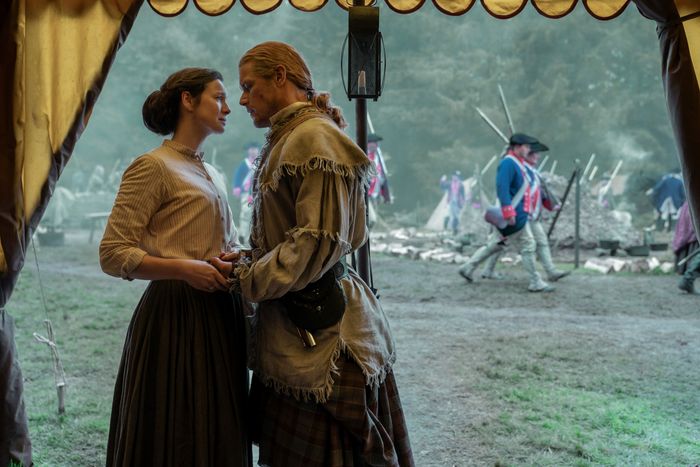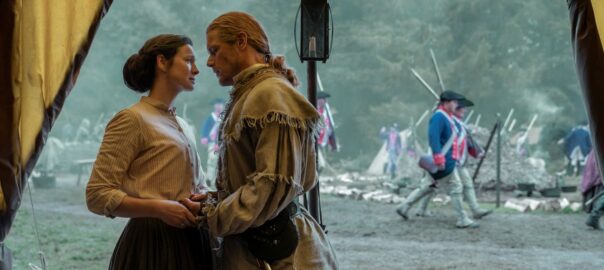[ad_1]

As the best sex on television takes a backseat, the series taps into a different type of desire: seeing our fears actualized and overcome.
Photo: Robert Wilson/Starz
When Outlander first premiered nine years ago, the Starz series was correctly hailed as having the best sex on television. The show placed that stake in the ground from its first episode, when Claire’s first husband, Frank, deftly goes down on her — fully dressed except for her knickers! — within the dreary grounds of Castle Leoch after the end of World War II.
But Outlander is more than steamy sex scenes. That first episode, in fact, begins with Claire covered in blood as she tries to save a soldier’s horribly mangled leg. She works through bone, tendons, and arteries to preserve the man’s life, a stark contrast to the castle cunnilingus a few minutes later. Through this juxtaposition, the series sets up the thematic contrast at its core: Desire with emphasis on the female gaze, yes, but also perseverance in the face of horrific events (also from the female gaze).
It was the naked kissing in the first few seasons, however, that understandably captured people’s attention. When Claire finds herself transported to the 18th century and wed to young Scot Jamie, their amorous entanglements couldn’t be hotter. Even in season three, when they’re reunited after 20 years apart — older but still incredibly attractive — Jamie and Claire continue to get it on with gusto. Other characters get in on hot-and-heavy action of their own as the series progresses, including their daughter Bree and her husband Roger, although none compare to Jamie and Claire’s passion.
But Jamie and Claire’s sexy times have taken a backseat in recent seasons, which have seen the balance tip further toward these characters’ hardships. Last season saw Claire and Jamie back on their homestead on Fraser’s Ridge, where Claire, recovering from getting gang raped (yet another instance of the show overusing rape for dramatic effect), turns to inhaling ether as an escape. As she’s struggling through this trauma, she is accused of murdering a young pregnant woman who claims she had an affair with Jamie. The finale saw her being hauled off for trial and a presumed hanging. Claire is full of torment in these episodes, and while it’s inarguably less fun to watch than the sex scenes on which this show built its reputation, it also reveals the other fundamental desire at the heart of Outlander, one that’s not far removed from many people’s — especially women’s — fascination with true crime: We want to see our fears actualized.
Outlander makes Claire and Jamie suffer, but unlike most true crime, they survive and continue on without losing the core of who they are. Claire perseveres through her season-six hardships, getting out of jail and back into Jamie’s arms relatively quickly in the beginning of season seven, which is still relatively devoid of passionate embraces in the buff. The Frasers are caught up in the Revolutionary War, and while there have been plenty of very long, loving moments, such as when Jamie and Claire say goodbye to Bree, Roger, and their children as they go through the stones to return to the 1980s, these moments aren’t defined by sexual desire. Instead, we get characters like Mrs. Raven, the traumatized woman who is a shell of her former self after her family was killed at Fort Ticonderoga. The violence and trauma she’s witnessed subsume her with panic, fear, and despair, and end with her putting a bullet through her head right in front of Claire, giving our heroine one more traumatic episode on her ledger.
Naturally, things don’t improve from there. Just after Claire sees Mrs. Raven die, she’s captured by the British and penned up at the camp with other prisoners, including a woman with a small baby and Walter, a man with an amputated leg who Claire had to leave behind at Fort Ticonderoga. But as has been well-established, going all the way back to that series-opening shot, Claire doesn’t wilt when facing dire straits: Instead of giving into fear, she does what she can to make things better, dressing down the Redcoat watching over them and demanding food, water, and medicine. Only when Young Ian rescues her (and after Walter dies in captivity from a pulmonary embolism, another devastation Claire has to carry with her), does she let her let her guard down in Jamie’s loving embrace, a moment almost as stirring as the lauded sex scenes of seasons past — arguably more so. That embrace is the reassuring promise that Claire and Jamie are together, alive, and still ardently in love after all they’ve endured in their years together and apart.
Mrs. Raven’s plight and the magnitude of what Claire is put through is frankly par for the course for Outlander, but it all feels heavier now that it’s not offset by as many erotic escapades. At the same time, these moments are all the more resonant for illustrating how the insurmountable can be survivable, and give us solace in seeing a love that is unbreakable and unconditional. That promise is why, all this time and trauma later, we still tune in to see the Outlander cast get literally and figuratively pummeled. Each week, they endure, buoyed by an unflinching love and almost superhuman ability to shape themselves around their pain and trauma. What they’ve been through has hurt them, and they’re not stronger for it, necessarily, but they’re not diminished by it, either. They are survivors, stalwart in their beliefs and their love. We watch Outlander to see them persevere through every hardship and horror imaginable, because we dream of being like Claire and Jamie, even when we might feel closer to Mrs. Raven.
[ad_2]
Source link
